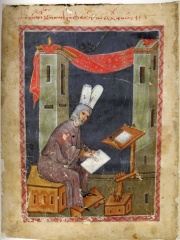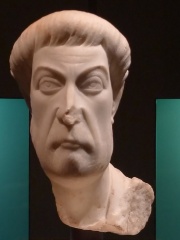



The Most Famous
HISTORIANS from Turkey
This page contains a list of the greatest Turkish Historians. The pantheon dataset contains 561 Historians, 5 of which were born in Turkey. This makes Turkey the birth place of the 20th most number of Historians behind China, and Netherlands.
Top 5
The following people are considered by Pantheon to be the most legendary Turkish Historians of all time. This list of famous Turkish Historians is sorted by HPI (Historical Popularity Index), a metric that aggregates information on a biography’s online popularity.

1. Niketas Choniates (1155 - 1217)
With an HPI of 70.76, Niketas Choniates is the most famous Turkish Historian. His biography has been translated into 40 different languages on wikipedia.
Niketas or Nicetas Choniates (Medieval Greek: Νικήτας Χωνιάτης; c. 1155 – 1217), whose actual surname was Akominatos (Ἀκομινάτος), was a Byzantine Greek historian and politician. He accompanied his brother Michael Akominatos to Constantinople from their birthplace Chonae (from which came his nickname, "Choniates" meaning "person from Chonae"). Nicetas wrote a history of the Eastern Roman Empire from 1118 to 1207.

2. Eutropius (320 - 400)
With an HPI of 67.69, Eutropius is the 2nd most famous Turkish Historian. His biography has been translated into 41 different languages.
Eutropius (fl. 363–387) was a Roman official and historian. His book Breviarium Historiae Romanae summarizes events from the founding of Rome in the 8th century BC down to the author's lifetime. Appreciated by later generations for its clear presentation and writing style, the Breviarium can be used as a supplement to more comprehensive Roman historical texts that have survived in fragmentary condition.

3. George Kedrenos (1100 - 1100)
With an HPI of 65.59, George Kedrenos is the 3rd most famous Turkish Historian. His biography has been translated into 29 different languages.
George Kedrenos, Cedrenus or Cedrinos (Greek: Γεώργιος Κεδρηνός, fl. 11th century) was a Byzantine Greek historian. In the 1050s he compiled Synopsis historion (also known as A concise history of the world), which spanned the time from the biblical account of creation to his own day. Kedrenos is one of the few sources that discuss Khazar polities in existence after the sack of Atil in 969 (see Georgius Tzul). Material in Synopsis historion mostly comes from the works by Pseudo-Symeon Magistros(de) (a version of Logothete's chronicle(de)), George Syncellus, Theophanes the Confessor, and, starting from 811, almost exclusively and word-for-word from the chronicle by John Skylitzes. One late manuscript of Synopsis historion preserves a poem (anonymous but thought to be by Kedrenos) that derives his family name from the place where he was born, a small village of Cedrus (or Cedrea) in the Anatolic Theme. The poem also identifies him as a proedrus, a senior court official. Before becoming a proedros, Kedrenos may have held the somewhat lower rank of vestarches. Vestarches Georgios Kedrenos is in fact known from a number of 11th–12th-century seals found mostly in the Danube region, but also in Crimea. Furthermore, several roughly contemporary seals refer to another court official, a certain "John Cedrenus, protocuropalates and duke" who may have been a relative, perhaps, a brother or a cousin.

4. Leo the Deacon (950 - 992)
With an HPI of 63.85, Leo the Deacon is the 4th most famous Turkish Historian. His biography has been translated into 26 different languages.
Leo the Deacon (Greek: Λέων ο Διάκονος; born c. 950) was a Byzantine Greek historian and chronicler. He was born around 950 at Kaloe in Asia Minor, and was educated in Constantinople, where he became a deacon in the imperial palace. While in Constantinople he wrote a history covering the reigns of Romanos II, Nikephoros II, John Tzimiskes, and the early part of the reign of Basil II. Often his observations were based on his experiences as an eyewitness to events. His writing style has been described as "Classical", as he employed language reminiscent of the poet Homer and other ancient Greek historians such as Agathias. Leo is particularly well known for his eyewitness description of Sviatoslav I of Kiev, who invaded Bulgaria in 969 and fought against Byzantine Imperial forces over its territory.

5. John Kinnamos (1143 - 1185)
With an HPI of 62.64, John Kinnamos is the 5th most famous Turkish Historian. His biography has been translated into 27 different languages.
Joannes Kinnamos, or John Cinnamus (Greek: Ἰωάννης Κίνναμος or Κίναμος; born shortly after 1143, died after 1185), was a Byzantine historian. He was imperial secretary (Greek "grammatikos", most likely a post connected with the military administration) to Emperor Manuel I (1143–1180), whom he accompanied on his campaigns in Europe and Asia Minor. It appears that Kinnamos outlived Andronikos I, who died in 1185. Kinnamos was the author of a history that covered the years 1118–1176, thereby continuing the Alexiad of Anna Komnene, and covering the reigns of John II and Manuel I, until Manuel's unsuccessful campaign against the Turks, which ended in defeat at the Battle of Myriokephalon. Kinnamos's work breaks off abruptly, though it is highly likely that the original continued to the death of Manuel. There are also indications that the present work is an abridgment of a significantly larger work. The hero of the history is Manuel, and throughout the history Kinnamos attempts to highlight what he sees as the superiority of the Byzantine Empire to the Western and other powers. Similarly, he is a determined opponent of what he perceives as the pretensions of the papacy. Nevertheless, he writes with the straightforwardness of a soldier, and occasionally admits his ignorance of certain events. The work is well organized, and its style, modeled on Xenophon, is simple, especially when compared with the florid writing of other Greek authors of the period. William Plate considers him the best of the European historians of this period. John Kinnamos is also credited for writing a book on one of the Angeli emperors; however, this book is believed to be lost (perhaps together with the rest of his much larger work).
People
Pantheon has 5 people classified as Turkish historians born between 320 and 1155. Of these 5, none of them are still alive today. The most famous deceased Turkish historians include Niketas Choniates, Eutropius, and George Kedrenos.
Deceased Turkish Historians
Go to all RankingsNiketas Choniates
1155 - 1217
HPI: 70.76
Eutropius
320 - 400
HPI: 67.69
George Kedrenos
1100 - 1100
HPI: 65.59
Leo the Deacon
950 - 992
HPI: 63.85
John Kinnamos
1143 - 1185
HPI: 62.64

